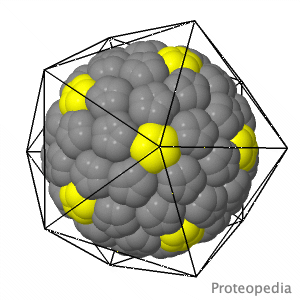Proteopedia:Featured EDU/10
From Proteopedia
(Difference between revisions)
(New page: <table> <tr><td> <imagemap> Image:2vv5-2oau-morf-mechanosensitive-channel.gif|center default Drug and peptide transport in humans </imagemap> </td></tr> <tr><td><div class="scrolling">...) |
|||
| (2 intermediate revisions not shown.) | |||
| Line 2: | Line 2: | ||
<tr><td> | <tr><td> | ||
<imagemap> | <imagemap> | ||
| - | Image: | + | Image:1sva-simplified-with-icosahedron.gif|center |
| - | default [[ | + | default [[SV40 Capsid Simplified]] |
</imagemap> | </imagemap> | ||
</td></tr> | </td></tr> | ||
| - | <tr><td><div class="scrolling">''' | + | <tr><td><div class="scrolling">'''Virus Capsid Geometry'''<br> |
| - | + | The <i>Capsid</i> of a virus is its outer shell or "skin". Viruses have evolved intricate and elegant ways to assemble | |
| - | Pictured is | + | capsid protein chains into complete, usually spherical capsids, often with [https://en.wikipedia.org/wiki/Regular_icosahedron icosahedral symmetry]. Pictured is an extremely simplified model of a capsid, where a single enlarged atom represents each of the 360 protein chains in the capsid of the Simian Virus 40 (SV40), a member of a group of cancer-causing viruses that has been extensively researched for decades. |
| - | + | ||
| - | >>> [[ | + | >>> [[SV40 Capsid Simplified|See more animations and explanation]] >>> |
</div> | </div> | ||
</td></tr> | </td></tr> | ||
Current revision
Virus Capsid Geometry
The Capsid of a virus is its outer shell or "skin". Viruses have evolved intricate and elegant ways to assemble capsid protein chains into complete, usually spherical capsids, often with icosahedral symmetry. Pictured is an extremely simplified model of a capsid, where a single enlarged atom represents each of the 360 protein chains in the capsid of the Simian Virus 40 (SV40), a member of a group of cancer-causing viruses that has been extensively researched for decades. |


